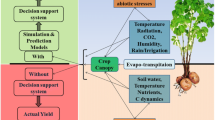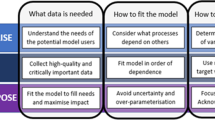Abstract
When we consider complex, multi-step processes such as crop growth or the progress of a disease then simple mathematical functions are inadequate to describe them and we generally use some kind of mathematical model. The commonest form in use is one that we call a simulation model although there are other forms of model such as Rule-based, (e.g. Gu et al. AI Appl 10:13–24, 1996), Bayesian (Gold, Plant Disease Epidemiol 4:84–122, 1989) and ‘fuzzy’ (Burrough, J Soil Sci 40:477–492, 1989), depending upon the application. Models may sometimes be combined into packages that we call decision support systems. This paper will consider simulation modelling and also the combination of complementary models. Mathematical models of the potato crop have been devised, in a range of sophistication, over a long period of years and a quite proper question is: “Where next? What are the developments that are sought or, more importantly, that are needed?”






Similar content being viewed by others
References
Abrahamsen P, Hansen S (2000) Daisy: an open soil–crop–atmosphere system model. Environ Model Softw 15:313–330
Andrade-Piedra JL, Forbes GA, Shtienberg D, Grünwald NJ, Chacón MG, Taipe MV, Hijmans RJ, Fry WE (2005) Qualification of a plant disease simulation model: performance of the LATEBLIGHT model across a broad range of environments. Phytopathology 95(12):1412–1422
Battilani A (2006) FERTIRRIGERE V2.11: a multi-target DSS to manage water and nutrients supply at macrozone level. IX ISHS Symposium on Processing Tomato, Melbourne Nov 15–18 2004. Acta Hortic 724:114–118
Battilani A, Bussières P, Dumas Y (2003) Fertirrigere: a simple tool-model for managing water and nutrient supply in drip-irrigated processing tomatoes. ISHS Acta Horticulturae 616: VIII International Symposium on the Processing Tomato 2003, pp 155–158
Belmans C, Dekker LW, Bouma J (1982) Obtaining soil physical field data for simulating soil moisture regimes and associated potato growth. Agric Water Manag 5:319–333
Belmans C, Wesseling GJ, Feddes RA (1983) Simulation model of the water balance of a cropped soil: SWATRE. J Hydrol 63:271–286
Bengough AG (1997) Modelling root depth and soil strength in a drying soil profile. J Theor Biol 186:327–338
Box GEP (1979) Robustness in the strategy of scientific model building. In: Launer RL, Wilkinson GN (eds) Robustness in statistics. Academic, New York
Burrough PA (1989) Fuzzy mathematical methods for soil survey and land evaluation. J Soil Sci 40:477–492
Caldiz DO (2000) Analysis of seed and ware potato production systems and yield constraints in Argentina. PhD thesis, University of Wageningen. Dissertation no. 2816
de Wit CT (1965) Photosynthesis of leaf canopies. Pudoc, Wageningen
Elliott MJ, Trudgill DL, McNicol JW, Phillips MS (2004) Projecting PCN population changes and potato yields in infested soils. In: MacKerron DKL, Haverkort AJ (eds) Decision support systems in potato production—bringing models to practice. Wageningen Academic, Wageningen, pp 142–152
FertOrgaNic (2008) http://www.fertorganic.org/FertOrgaNic.asp
Forrester JW (1961) Industrial dynamics. Pegasus Communications, Waltham
Gold HJ (1989) Decision analytic modelling for plant disease control. Plant Disease Epidemiol 4:84–122
Gu Y, McNicol JW, Peiris DR, Crawford JW, Marshall B, Jefferies RA (1996) A belief network-based system for predicting future crop production. AI Appl 10:13–24
Haverkort AJ, Grashoff C (2004) IDEOTYPING-POTATO a modelling approach to genotype performance. In: MacKerron DKL, Haverkort AJ (eds) Decision support systems in potato production—bringing models to practice. Wageningen Academic, Wageningen, pp 199–211
Jamieson PD, Stone PJ, Zyskowski RF, Sinton S, Martin RJ (2004) Implementation and testing of the Potato Calculator, a decision support system for nitrogen and irrigation management. In: MacKerron DKL, Haverkort AJ (eds) Decision support systems in potato production—bringing models to practice. Wageningen Academic, Wageningen, pp 84–99
Jefferies RA (1993a) Use of a simulation model to assess possible strategies of drought tolerance in potato (Solanum tuberosum L.). Agric Syst 41:93–104
Jefferies RA (1993b) Cultivar responses to water stress in potato: effects of shoot and roots. New Phytol 123:491–498
Johnson KB, Johnson SB, Teng PS (1986) Development of a simple potato growth model for use in crop-pest-management. Agric Syst 19:189–209
Kabat P, Marshall B, van den Broek BJ (1995a) Comparison of simulation results and evaluation of parameterization schemes. In: Kabat P, Marshall B, van den Broek BJ, Vos J, van Keulen H (eds) Modelling and parameterisation of the soil–plant–atmosphere system—a comparison of potato growth models. Pudoc, Wageningen, pp 439–501
Kabat P, Marshall B, van den Broek BJ, Vos J, van Keulen H (eds) (1995b) Modelling and parameterisation of the soil–plant–atmosphere system—a comparison of potato growth models. ISBN 90-74134-16-5, Pudoc, Wageningen, 523 pp
Kadaja J, Tooming H (2004) Potato production model based on principle of maximum plant productivity. Agric For Meteorol 127:17–33
Kirk WW (1986) Leaf and canopy development in the potato. PhD thesis, University of Dundee, 135 pp
LeDuc SK, Holt DA (1987) The scale problem: modeling plant yield over time and space. In: Wisiol K, Hesketh JD (eds) Plant growth modelling for resource management. CRC, Boca Raton, pp 125–137
MacKerron DKL (1984) Potato sprout emergence in soil as a function of temperature and time from planting. Abstracts of the 9th Triennial Conference, EAPR, Interlaken, p 364
MacKerron DKL, Lewis GJ (1995) Modelling to optimize the use of both water and nitrogen by the potato crop. In: Haverkort AJ, MacKerron DKL (eds) Potato ecology and modelling of crops under conditions limiting growth. Kluwer, Dordrecht, pp 129–146
MacKerron DKL, Peng ZY (1989) Genotypic comparisons of potato root growth and yield in response to drought. Aspects Appl Biol 22: Roots and the Soil Environment. 199–206
MacKerron DKL, Marshall B, McNicol JW (2004) MAPP, the Management Advisory Package for Potatoes: decision support means giving informed options not making decisions. In: MacKerron DKL, Haverkort AJ (eds) Decision support systems in potato production—bringing models to practice. Wageningen Academic, Wageningen, pp 118–141
Marshall B, van den Broek BJ (1995) Field experiments and analysis of data used in the case study. In: Kabat P, Marshall B, van den Broek BJ, Vos J, van Keulen H (eds) Modelling and parameterisation of the soil–plant–atmosphere system—a comparison of potato growth models. Pudoc, Wageningen, pp 179–210
Neeteson JJ (1982) Investigation into the relationship between amount of soil mineral nitrogen and optimum nitrogen fertilization for potatoes and sugar beet. Assessment of the nitrogen status of the soils (Research Workshop Leuven, 12–14 Jan 1982), pp 44–47
Neeteson JJ (1990) Development of nitrogen fertilizer recommendations for arable crops in the Netherlands in relation to nitrate leaching. Fertil Res 26:291–298
Ng E, Loomis RS (1979) A simulation model of potato crop growth. Final report for co-operative agreement No. 12-14-5001-287 with the USDA Snake River Conservation Research Center
Ng E, Loomis RS (1984) Simulation of growth and yield of the potato crop. PUDOC, Wageningen ISBN 90-220-0843-6
OPTIRas (2006) http://optiras.agrobiokon.eu/
OPTIRas (2008) http://optiras.agrobiokon.nl/optiras3/index.faces
Parker CJ, Carr MKV, Jarvis NJ, Evans MTB, Lee VH (1989) Effects of subsoil loosening and irrigation on soil physical properties, root distribution and water uptake of potatoes. Soil Tillage Res 13:267–285
Peng TY (1989) The physiological basis of genotypic differences in drought tolerance in potatoes. MSc thesis, University of Dundee
Raatjes P, Hadders J, Martin D, Hinds H (2004) PLANT-Plus: turn-key solution for disease forecasting and irrigation management. In: MacKerron DKL, Haverkort AJ (eds) Decision support systems in potato production—bringing models to practice. Wageningen Academic, Wageningen, pp 168–185
Rose CW, Begg JE, Byrne GF, Torssel BWR, Goncz JH (1972) A simulation model of growth–field environment relationships for Townsville stylo (Stylosanthes humilis H.B.K.) pasture. Agric Meteorol 10:161–183
Roth O, Derron J, Fischlin A, Nemecek T, Ulrich M (1995) Implementation, parameter adaptation, and integration of a potato crop and a soil water simulation model. In: Kabat P, Marshall B, van den Broek BJ, Vos J, van Keulen H (eds) Modelling and parameterisation of the soil–plant–atmosphere system—a comparison of potato growth models. Pudoc, Wageningen, pp 371–399
Sporleder MJ, Kroschel MR, Gutierrez Q, Lagnaoui A (2004) A temperature-based simulation model for the potato tuber worm, Phthorimaea operculella Zeller. Lepidoptera Gelechiidae. Environ Entomol 33(3):477–486
Sterman JD (2002) All models are wrong: reflections on becoming a systems scientist. Syst Dyn Rev 18:501–531
Timmermans BGH, Vos J, Stomph TJ (2009) The development, validation and application of a crop growth model to assess the potential of S. sisymbriifolium as a trap crop for potato cyst nematodes in Europe. Field Crops Res (in press).
USDA (2007) Crop simulation models and GUICS http://www.ars.usda.gov/Research/docs.htm?docid=6339
van den Broek BJ, Kabat P (1995) SWACROP: dynamic simulation model of soil water and crop yield applied to potatoes. In: Kabat P, Marshall B, van den Broek BJ, Vos J, van Keulen H (eds) Modelling and parameterisation of the soil–plant–atmosphere system—a comparison of potato growth models. Pudoc, Wageningen, pp 299–333
Van Keulen H, Stol W (1995) Agro-ecological zonation for potato production. In: Haverkort AJ, MacKerron DKL (eds) Potato ecology and modelling of crops under conditions limiting growth. Kluwer, Dordrecht, pp 357–372
Van Keulen H, Wolf J (eds) (1986) Modelling of agricultural production: weather, soils and crops. Simulation Monograph Series, Pudoc Wageningen, 479 pp
Wolf J, van Oijen M (2003) Model simulation of effects of changes in climate and atmospheric CO2 and O3 on tuber yield potential of potato (cv. Bintje) in the European Union. Agric Ecosyst Environ 94:141–157
Author information
Authors and Affiliations
Corresponding author
Rights and permissions
About this article
Cite this article
MacKerron, D.K.L. Advances in Modelling the Potato Crop: Sufficiency and Accuracy Considering Uses and Users, Data, and Errors. Potato Res. 51, 411–427 (2008). https://doi.org/10.1007/s11540-008-9108-z
Received:
Accepted:
Published:
Issue Date:
DOI: https://doi.org/10.1007/s11540-008-9108-z




